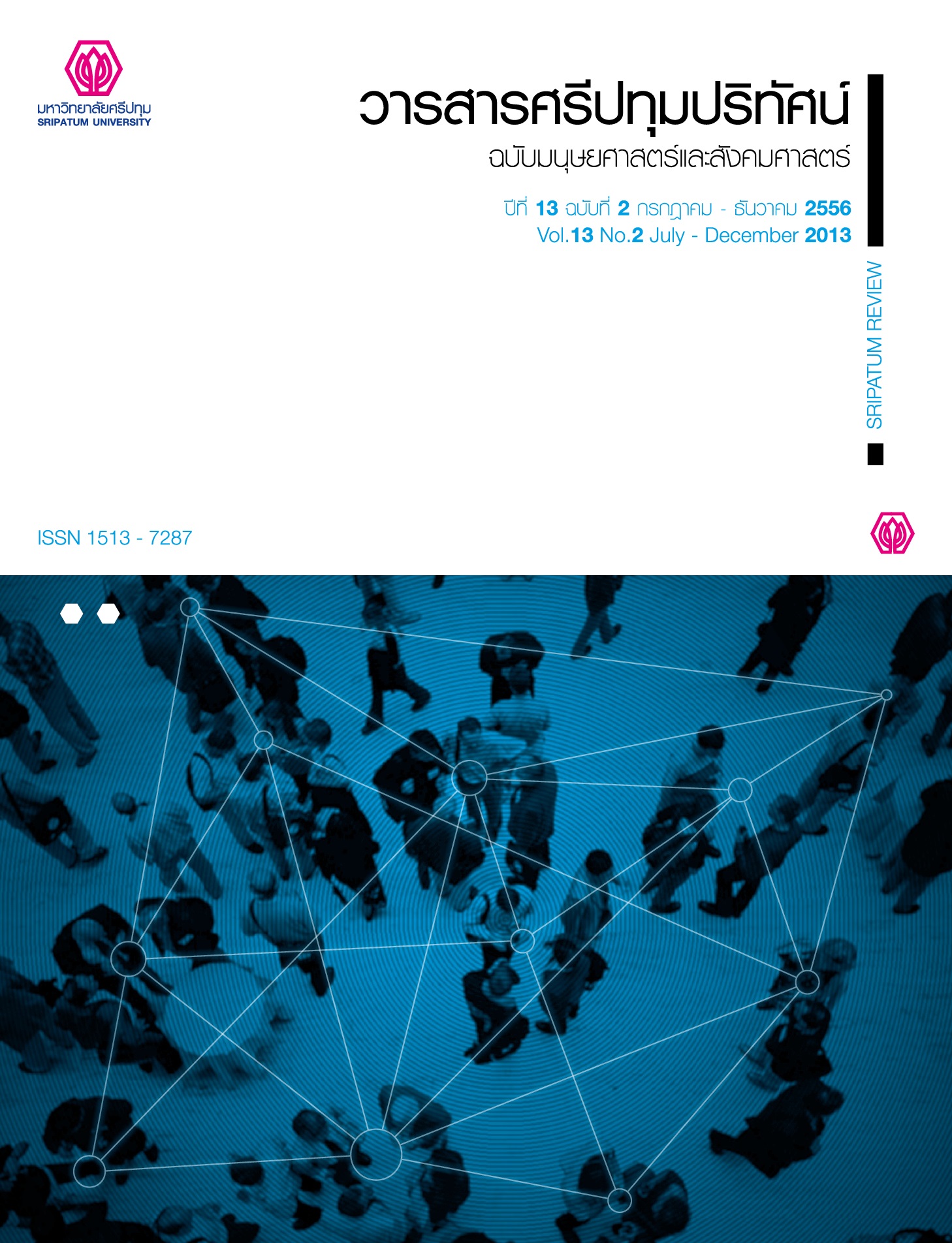COLLABORATION-ORIENTED LEARNING OBJECTS BASED ON CONSTRUCTIVISM THEORY
Main Article Content
Abstract
The purposes of this research were 1) to develop the collaboration-oriented
learning objects based on Constructivism Theory (COLOC); and 2) to assess the students’ leaning quality by authentic assessment.
The research sample consisted of 40 undergraduate students in the Faculty of Information Technology, Sripatum University, who enrolled in the Introduction to E-Business Course in the first semester of academic year 2011.
The research methodology was divided into three phases. The First Phase was the synthesis of the model using focus group discussion to obtain ideas from the experts; the Second Phase was the development of research instruments and try-out of the developed model; and the Third Phase was the assessment of the students’ learning quality by authentic assessment.
The research findings showed that 1) the developed COLOC model was approved by experts as appropriate at the highest level; this model was composed of eight features and three phases of learning process; the eight features of the model were being digital media, learnability, congruency with learning objectives, granularity, reusability, adaptability, interoperability, and accessibility; it operated within the environment that facilitated social negotiation and sharing of understanding from collaborative learning based on three phases of constructivist learning process, namely, the preparation phase, the restructuration phase, and the application phase in other situations; and 2) the students’ overall learning quality based on results of authentic assessment was at the very good level.
Article Details
1. กองบรรณาธิการสงวนสิทธิ์ในการพิจารณาและตัดสินการตีพิมพ์บทความในวารสาร
2. บทความทุกเรื่องจะได้รับการตรวจสอบทางวิชาการโดยผู้ทรงคุณวุฒิ แต่ข้อความและเนื้อหาในบทความที่ตีพิมพ์เป็นความรับผิดชอบของผู้เขียนแต่เพียงผู้เดียว มิใช่ความคิดเห็นและความรับผิดชอบของมหาวิทยาลัยศรีปทุม
3. การคัดลอกอ้างอิงต้องดำเนินการตามการปฏิบัติในหมู่นักวิชาการโดยทั่วไป และสอดคล้องกับกฎหมายที่เกี่ยวข้อง
References
ถนอมพร เลาหจรัสแสง. 2550. “นิยาม เลิร์นนิงออปเจ็กต์ (Learning Object) เพื่อการออกแบบพัฒนาสื่ออิเล็กทรอนิกส์.” วารสารเทคโนโลยีและสื่อสารการศึกษมหาวิทยาลัยสุโขทัยธรรมาธิราช 4 (4): 50-59.
ทิศนา แขมมณี และคณะ. 2545. กระบวนการเรียนรู้: ความหมาย แนวทางการพัฒนาและปัญหาข้องใจ. สนับสนุนโดยสำนักงานกองทุนสนับสนุนการวิจัย โครงการเบื้องต้นการศึกษาข้อมูลพื้นฐานและทบทวนองค์ความรู้สำหรับการพัฒนากระบวนการเรียนของระบบโรงเรียนให้สอดคล้องกับพระราชบัญญัติการศึกษา พ.ศ.2542.
พิมพ์พันธ์ เดชะคุปต์ และพเยาว์ ยินดีสุข .2552 . Backward Design & chind-centered. กรุงเทพฯ : โรงพิมพ์แห่งจุฬาลงกรณ์มหาวิทยาลัย.
บัญญัติ ชำนาญกิจ. 2549. 24 เทคนิคการจัดการเรียนรู้แบบร่วมมือ.
ไพจิตร สะดวกการ. 2543. เรียนผูกเรียนแก้: ภูมิปัญญาไทยที่สอดรับกับทฤษฏีคอนสตรัคติวิสต์และการปฏิรูปการศึกษา. ม.ป.ท.
วัฒนาพร ระงับทุกข์. 2545. เทคนิคและกิจกรรมการเรียนรู้ที่เน้นผู้เรียนเป็นสำคัญ. กรุงเทพมหานคร: สำนักพิมพ์พริกหวานกราฟฟิก.
สติยา ลังการ์พินธุ์. 2548. “การสร้าง Learning Object .” วารสาร สสวท 33 (134).
สุมาลี ชัยเจริญ . 2550. เทคโนโลยีการศึกษา หลักการ ทฤษฏีสู่การปฏิบัติ. กรุงเทพมหานคร: สำนักบริการคอมพิวเตอร์ มหาวิทยาลัยขอนแก่น.
อุดม รัตนอัมพรโสภณ. 2549. การเรียนแบบร่วมมือ.
David Walbert. 2011. ITS Teaching and Learning - Carolina Digital Repository . (Online).
George W. Gagnon, Jr. and Michelle Collay. 1996. Constructivist Learning Design. (Online).
John B. Black and Robert O. McClintock.1995. An interpretation Construction Approach Constructivst Design. Columbia University. (Online).
Muammer ÇALIK, Alipasa AYAS and Richard K. COLL,2006. “A constructivist-based Model for the teaching of dissolution of gas in a liquid.” Asia-Pacific Forum on Science Learning and Teaching, Volume 7, Issue 1, Article 4 (June, 2006).(Online).
Rosalind Driver. 1988 . Constructivism and Leaning.
Thirteen Organize. 2004 . What are Cooperative and Collaborative learning. (Online).
Yahya. Y. and M. Yusoff. 2006. Learning Object Model Recognition Based On Theoretical Grounds.


